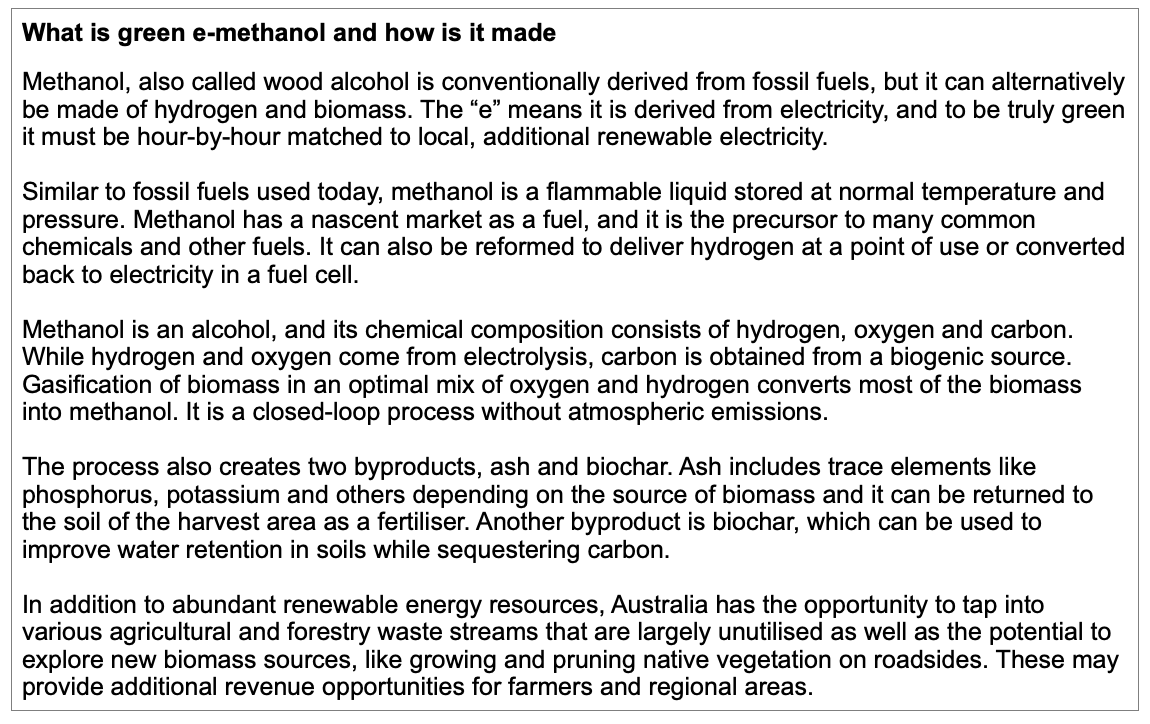An alternative form of storage with an order of magnitude cheaper capital cost is e-methanol. This ultra-deep storage can also double as a national fuel security strategy.
Converting electricity to hydrogen and then back to electricity is criticised due to the high round-trip losses – and the same would apply to e-methanol. However, in this case, the round-trip efficiency is not relevant altogether because the stored e-methanol is not turned back into electricity but used as a commodity.

Instead of using the ultra-deep e-methanol storage like a traditional “charge and discharge” battery, it can be optimised as a flexible load or as part of a larger asset ecosystem.
Let’s first assume that the e-methanol production plant capacity is fully utilised, i.e. it sells e-methanol through continuous supply contracts and runs 24/7 on carbon-free electricity. By adding extra storage capacity, the plant can occasionally deliver the e-methanol from the tanks instead of from the production line and effectively release the electricity back to the market, just like a discharging battery would. A relatively small amount of extra production capacity is also required to slowly refill the tanks after use.
While such a plant could operate as a stand-alone unit – subject to the availability of green baseload electricity – there are additional benefits of optimising it as part of an asset ecosystem such as Superhybrid developed by Sunshine Hydro.
A Superhybrid consists of long-duration energy storage and flexible load like e-methanol production, optimised by a purpose-built software called AESOP. The system buys large quantities of wind and solar and uses the assets to transform the intermittent generation into a long-term baseload-type electricity supply. The excess energy is converted into hydrogen and green fuels that are also sold through steady-stream supply contracts. Additionally, Superhybrid sells peak power and grid support services on the market.
There is no technical upper limit for the depth of the e-methanol storage because it is modular and can be easily expanded by adding more tanks. Furthermore, the optimisation of electrolysers can also respond to short-term daily peaks and provide grid support in a normal market situation, earning extra revenues and providing downward pressure on consumer prices.
Fuel security
While this article focuses on e-methanol as a national electricity security reserve, we must point out that it can alternatively – and to an extent simultaneously – act as a fuel reserve that keeps food trucks and other heavy transport on the road.
There are trucks available today that run on methanol and are offered by various truck vendors such as Geely (China), Ashok-Leyland (India) and Dor (Israel). These vehicles use internal combustion engines, providing an easy first step in decarbonising transport to run on methanol. Alternatively, methanol can be used in a fuel cell to power an electric vehicle or other devices – for example, it is currently used to power remote telecommunications sites.
Methanol is rapidly gaining market share in the marine sector with 10% of the ships contracted this year able to run on methanol. Smaller vessels such as tugs are already running on methanol as a fuel both in reciprocating engines and soon on fuel cells.
As the transport and delivery logistics chains develop it becomes increasingly easy to use methanol in other industries such as agriculture, construction and mining – which are further important sectors for national security and resilience.
It’s time for national fuel security to turn green as well.
For a decade Australia has fallen short of its obligation to stock at least 90 days of oil net imports as a member of the International Energy Agency (IEA). Transition to e-methanol would simultaneously reduce the need to import oil and enable stockpiling alternatives that would be subsidised through electricity market optimisation.
Capital costs
It is very challenging or virtually impossible to build a pumped hydro station with three months of storage, and even more so using batteries. However, these are the closest comparisons to make when assessing the capital cost of deep e-methanol storage.
The capital cost of Borumba Pumped Hydro Project in Queensland is estimated at $14.2 billion (USD 9.06 billion). It’s a 2,000 MW pumped hydro station with 24-hour reservoir and is planned to be operational by 2030. The capital cost relative to energy capacity is nearly $300 per kWh (this is the price of installed capacity, not LCOE, levelised cost of energy).
The price of a 12-hour vanadium flow battery system with 100 MW power capacity is currently over $800 million. This is about $700 per kWh installed. Both alternatives are economically challenging as a stand-alone business, to say the least.
When energy is stored by using a surrogate as “electricity not needed in the production,” the investment only needs to cover the incremental increase in production capacity, storing the product and managing the stockpile.
For example, let’s look at a methanol plant that draws 100 MW of 24/7 carbon-free electricity from the grid (or from an asset ecosystem like Superhybrid) to supply 300 tonnes of e-methanol per day through a long-term contract. Let’s then add a three-month ultra-deep storage capability to it and allow two years to build the storage up. The capex spent on the extra electrolysers and storage tanks is about $70 million – an order of magnitude cheaper than the alternatives (if they are scaled to the same power capacity when discharging, i.e. 100 MW).
However, the starkest comparison comes from capex per energy capacity. In this example, it is $0.32 per kWh for energy storage that can last three months. Pumped hydro capex per kWh is over 900 times more for one day of storage and the battery capex is over 2,000 times more for half a day. Ultra-long duration storage may just have started to make economic sense – even though there are still no market structures to truly incentivise it.
The opportunities ahead
This is an example of how thinking outside of the box can reveal opportunities to increase resilience and accelerate decarbonising our electricity grid and even provide additional benefits. The electricity sector needs to think creatively to identify energy-intensive products that can be easily stored and stockpiled and where the production process enables some level of ramping.
Typically, these businesses would be focused on maximising production and minimising shelf life, so it’s up to the energy sector, together with the governments, to incentivise the change. Perhaps, in addition to synthetic fuels like e-methanol or Sustainable Aviation Fuel (SAF), further examples could be found in cryogenic distillation or elsewhere in chemical processes.
About Sunshine Hydro
Sunshine Hydro is currently open for crowdfunding investment through Birchal. Always consider the general CSF (crowd sourced funding) risk warning and offer document before investing.
The views and opinions expressed in this article are the author’s own, and do not necessarily reflect those held by pv magazine.
This content is protected by copyright and may not be reused. If you want to cooperate with us and would like to reuse some of our content, please contact: editors@pv-magazine.com.








By submitting this form you agree to pv magazine using your data for the purposes of publishing your comment.
Your personal data will only be disclosed or otherwise transmitted to third parties for the purposes of spam filtering or if this is necessary for technical maintenance of the website. Any other transfer to third parties will not take place unless this is justified on the basis of applicable data protection regulations or if pv magazine is legally obliged to do so.
You may revoke this consent at any time with effect for the future, in which case your personal data will be deleted immediately. Otherwise, your data will be deleted if pv magazine has processed your request or the purpose of data storage is fulfilled.
Further information on data privacy can be found in our Data Protection Policy.